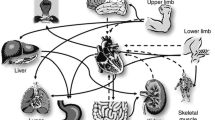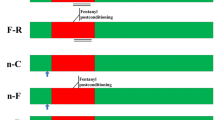Abstract
Elucidation of the subcellular mechanism of myocardial ischemic preconditioning should be facilitated by precise knowledge of the biology of the cardioprotective response. Any proposed molecular mechanism for preconditioning must be initiated during the required ischemic stress period. The studies reported in this paper were under-taken to determine whether the infarct-limiting effect of four 5-min episodes of ischemia interspersed by reperfusion can be achieved by a single 5-min episode. Adult openchest mongrel dogs, premedicated with the analgesic butorphanol, and anesthetized with sodium pentobarbital, underwent occlusion of the circumflex coronary artery for 60 min, followed by reperfusion for 3 h. Treated dogs were preconditioned with one, two or four cycles of 5-min occlusion followed by reperfusion. Additional dogs, not premedicated with butorphanol, were either untreated (not preconditioned) or preconditioned with one cycle of ischemia. Infarcts were identified using triphenyl-tetrazolium chloride (TTC) macrochemistry and infarct size (as % of area-at-risk, AAR) was measured and analyzed (using analysis of covariance [ANCOVA]) with respect to coronary collateral blood flow (measured using radio active microspheres). Four 5-min cycles of preconditioning ischemia markedly limited infarct size. Two cycles were as effective as four. In contrast, infarct size was not different from control infarct size after a single episode of preconditioning ischemia. However, when pentobarbital anesthesia was used without premedication with butorphanol, a single 5-min ischemic stress did induce cardioprotection. Thus, the ischemic stress required for myocardial preconditioning in dogs is dependent on the anesthetic and premedication protocol employed. A single 5-min stimulus is effective in dogs anesthetized with pentobarbital. Premedication with the opioid analgesic, butorphanol, increases the threshold for induction of cardioprotection.
Similar content being viewed by others
References
Goto M, Liu Y, Yang X-M, Ardell JL, Cohen MV, Downey JM (1995) Role of bradykinin in protection of ischemic preconditioning in rabbit hearts. Circ Res 77: 611–621
Gross GJ, Auchampach JA (1992) Blockade of ATP-sensitive potassium channels prevents myocardial preconditioning in dogs. Circulation 70: 223–233
Grover GJ, Sleph PG, Dzwonczyk S (1992) Role of myocardial ATP-sensitive potassium channels in mediating preconditioning in the dog heart and their possible interaction with adenosine A1-receptors. Circulation 86: 1310–1316
Haessler R, Kuzume K, Chien GL, Wolff RA, Davis RF, Van Winkle DM (1994) Anaesthetics alter the magnitude of infarct limitation by ischaemic preconditioning. Cardiovasc Res 28: 1574–1580
Li GC, Vasquez JA, Gallagher KP, Lucchesi BR (1990) Myocardial protection with preconditioning. Circulation 82: 609–619
Murry CE, Jennings RB, Reimer KA (1986) Preconditioning with ischemia: A delay of lethal cell injury in ischemic myocardium. Circulation 74: 1124–1136
Murry CE, Richard VJ, Reimer KA, Jennings RB (1990) Ischemic preconditioning slows energy metabolism and delays ultrastructural damage during a sustained ischemic episode. Circ Res 66: 913–931
Narita M, Makimura M, Feng Y, Hoskins B, Ho IK (1994) Influence of chronic morphine treatment on protein kinase C activity: Comparison with butorphanol and implication for opioid tolerance. Brain Res 650: 175–179
Ocaña M, Del Pozo E, Barrios M, Robles LI, Baeyens JM (1990) An ATP dependent potassium channel blocker antagonizes morphine analgesia. Eur J Pharmacol 186: 377–378
Pircio AW, Gylys JA, Cavanagh RL, Buyniski JP, Bierwagen ME (1976) The pharmacology of butorphanol, a 3,14-dihydroxymorphinan narcotic antagonist analgesic. Arch Int Pharmacodyn 220: 231–257
Reimer KA, Jennings RB, Cobb FR, Murdock RH Jr, Greenfield JC Jr, Becker LC, Bulkley BH, Hutchins GM, Schwartz RP Jr, Bailey KR, Passamani ER (1985) Animal models for protecting ischemic myocardium: Results of the NHLBI cooperative study. Comparison of the unconscious and conscious dog models. Circ Res 56: 651–665
Schultz JEJ, Hsu AK, Gross GJ (1996) Morphine mimics the cardioprotective effect of ischemic preconditioning via a glibenclamide-sensitive mechanism in the rat heart. Circ Res 78: 1100–1104
Schultz JEJ, Rose E, Yao Z, Gross GJ (1995) Evidence for involvement of opioid receptors in ischemic preconditioning in rat hearts. Am J Physiol (heart Circ Physiol) 268: H2157-H2161
Vander Heide RS, Schwartz LM, Jennings RB, Reimer KA (1995) Effect of catecholamine depletion on infarct size in dogs: Role of catecholamines in ischemic preconditioning. Cardiovasc Res 30: 656–667
Vander Heide RS, Schwartz LM, Reimer KA (1994) The novel calcium antagonist Ro 40-5967 limits myocardial infarct size in the dog. Cardiovasc Res 28: 1526–1532
Vergoni AV, Scarano A, Bertolini A (1992) Pinacidil potentiales morphine analgesia. Life Sciences 50: 135–138
Wild KD, Vanderah T, Mosberg HI, Porreca F (1991) Opioid & receptor subtypes are associated with different potassium channels. Eur J Pharmacol 193: 135–136
Author information
Authors and Affiliations
Rights and permissions
About this article
Cite this article
Schwartz, L.M., Jennings, R.B. & Reimer, K.A. Premedication with the opioid analgesic butorphanol raises the threshold for ischemic preconditioning in dogs. Basic Res Cardiol 92, 106–114 (1997). https://doi.org/10.1007/BF00805571
Received:
Revised:
Accepted:
Issue Date:
DOI: https://doi.org/10.1007/BF00805571




